
Economics_-_New_Ways_of_Thinking
.pdf
Why Is It?
So Easy to Put On Weight?
Some people want to lose weight for health reasons,
but they often find this hard to do. Why? Part of the answer has to do with the marginal cost of eating that additional hamburger, or slice of pie, or ice cream cone.
Suppose Larry weighs 200 pounds, and he wants to get down to a weight of 185 pounds for health reasons. When eating, Larry makes incremental (one in a series of many) decisions as opposed to all-or-nothing decisions. An all-or- nothing decision would be deciding whether to eat or not. This decision isn’t the one Larry has to make. He knows he is going to eat.
The decision he must make is how much to eat, which is an incremental decision. Does he eat two strips of bacon or just one? Does he have a big piece of cake or a small piece of cake? Does he have three sodas a day or only two?
Suppose the decision in front of Larry is whether to have half of a tuna sandwich or a whole tuna sandwich. Larry knows that he will eat at least half a tuna sandwich, so the real decision is whether to eat the extra half sandwich. When the increments are small (such as a half sandwich), eating it isn’t likely to add much weight. So, for Larry, the
marginal cost (in weight) of eating additional half sand wich is likely to be small. Maybe he will be two
ounces heavier than he would have been had he not eaten the
additional half sand wich.
What happens that because all of
sions about eating are really small incremental decisions (a little larger slice of pie, one more potato chip, one more cookie), it is likely that the marginal cost of each extra unit of food is going to be small. And so Larry will think to himself, What is a slightly larger slice of pie going to do? Very little.
Of course, a slightly larger slice of pie will do very little if things stop there. In fact, Larry has a series of incremental decisions to make—one more sip of soda, one more bit of mashed potatoes, one more cookie, and so on. It is only when we add together all the individually tiny incremental decisions that Larry makes do we learn that he has probably eaten more than he wanted to.
Larry’s type of thinking is similar to what happens when people litter. They ask themselves, What will one tiny piece of paper really matter?
What will a toothpick thrown on the ground matter? Well, if only one tiny piece of paper, or one tiny toothpick, was thrown on the ground, it
wouldn’t matter much. If, however, the same thing happens time after time, the litter is going to build up and then we’ll have a lot of trash thrown on the ground.
In summary, a series of tiny incremental decisions decided in a certain way, whether they have to do with eating or littering, can end up producing an aggregate outcome no one really intends. That’s why Larry sometimes asks why it is just so hard for him to lose weight when, he says to himself, he wants to lose weight so badly.
|
|
1. What are some diet- |
|
THINK |
|
|
ABOUT IT |
ing rules that Larry |
could make for himself that would |
||
greatly increase the costs of breaking the rules?
2. Do you ever litter? If so, what have been the costs to you in the situations where you have littered? Could those costs have been increased? If so, how?
174 Chapter 7 Business Operations
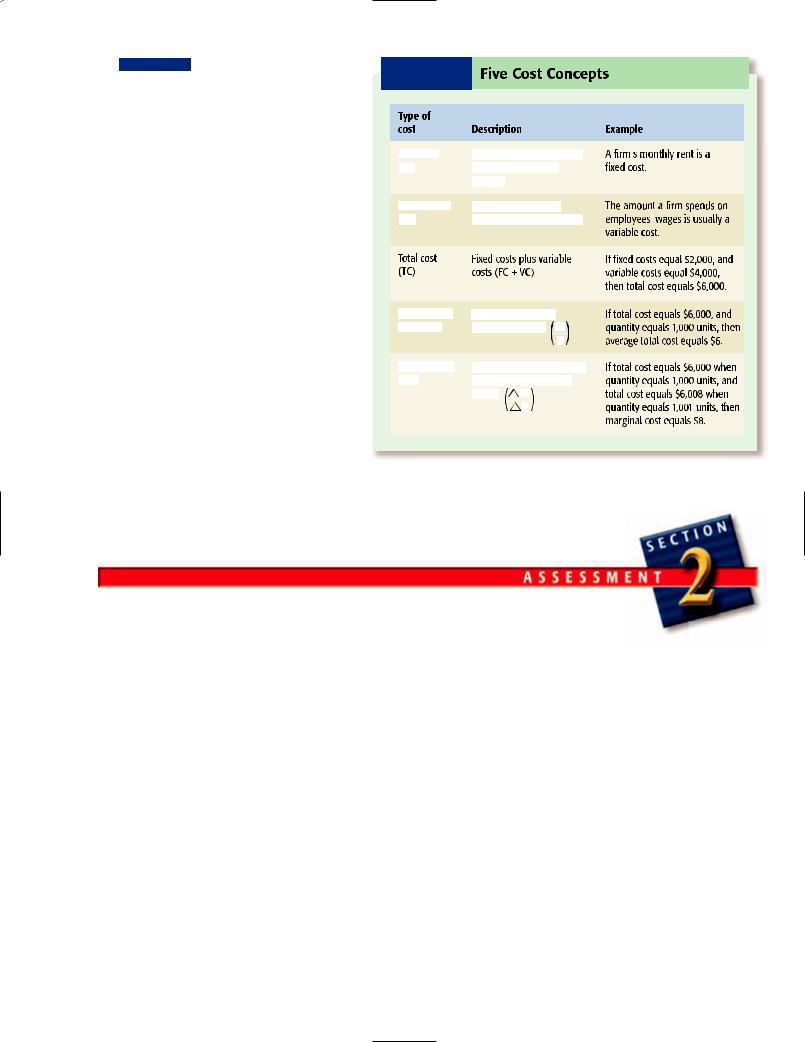
Harry produced 10 chairs and the total cost is $1,000. Harry goes on to produce one more chair (the 11th chair) and his total cost rises to $1,088. The marginal cost of chairs is $88—the additional cost of producing the additional (which in this case was the 11th ) chair.
 Flight 23 is almost ready to depart for Miami. Currently 98 out of the 100 seats are occupied. Jones walks up to the ticket agent and asks to get on the plane. The ticket agent says that the ticket price is $400. Jones says,“That is an outrageous price to pay to get on a plane that is headed to Miami whether I get on it or not. In fact, the additional cost (marginal cost) for me to travel on the plane is probably near zero. The airline doesn’t have to pay any more for gas, it doesn’t have to pay the pilot any more, it doesn’t have to pay the flight attendants any more, and so on. The only thing it has to do is give me a ‘free coke’ if I ask for it, and to tell you the truth I don’t mind paying for the coke myself. Here’s $1.50.” Is Jones right? Is the marginal cost of his traveling on the airplane close to zero for the air-
Flight 23 is almost ready to depart for Miami. Currently 98 out of the 100 seats are occupied. Jones walks up to the ticket agent and asks to get on the plane. The ticket agent says that the ticket price is $400. Jones says,“That is an outrageous price to pay to get on a plane that is headed to Miami whether I get on it or not. In fact, the additional cost (marginal cost) for me to travel on the plane is probably near zero. The airline doesn’t have to pay any more for gas, it doesn’t have to pay the pilot any more, it doesn’t have to pay the flight attendants any more, and so on. The only thing it has to do is give me a ‘free coke’ if I ask for it, and to tell you the truth I don’t mind paying for the coke myself. Here’s $1.50.” Is Jones right? Is the marginal cost of his traveling on the airplane close to zero for the air-
E X H I B I T 7-5 Five Cost Concepts
Type of
cost |
Description |
Example |
Fixed cost |
|
|
Cost, or expense, that does |
||||
|
|
|
|
|
|
|
|
(FC) |
|
|
|
not change as output |
|
|
|
|
|
|
|
|
|
|
|
|
|
|
|
changes |
|||
|
|
|
|
|
|||
Variable cost |
Cost, or expense, that |
||||||
|
|
|
|
||||
(VC) |
|
|
changes as output changes |
||||
Total cost |
Fixed costs plus variable |
(TC) |
costs (FC + VC) |
Average total |
|
|
Total cost divided by |
|
|
|
|
|
||||||||||
|
|
|
|
|
|
|
|
|
|
|
|
|
|
|
|
|
||
cost (ATC) |
|
|
||||||||||||||||
|
|
|
quantity of output |
|||||||||||||||
|
|
|
TC |
|||||||||||||||
|
|
|
|
|
|
|
|
|
|
|
|
|
|
|
Q |
|
||
|
|
|
|
|
|
|
|
|
|
|
|
|
|
|
|
|
||
Marginal cost |
|
|||||||||||||||||
|
|
Change in total cost divided |
||||||||||||||||
|
|
|
|
|
|
|
|
|
|
|
|
|
|
|
||||
(MC) |
|
|
|
|
||||||||||||||
|
|
|
|
by change in quantity of |
|
|||||||||||||
|
|
|
|
|
|
|
|
|
|
|
|
|
||||||
|
|
|
|
|
output |
|
|
TC |
||||||||||
|
|
|
|
|
|
|
|
|
|
|
|
|||||||
|
|
|
|
|
|
|
|
Q |
||||||||||
A firm s monthly rent is a fixed cost.
s monthly rent is a fixed cost.
The amount a firm spends on employees wages is usually a variable cost.
wages is usually a variable cost.
If fixed costs equal $2,000, and variable costs equal $4,000,
then total cost equals $6,000.
If total cost equals $6,000, and quantity equals 1,000 units, then average total cost equals $6.
If total cost equals $6,000 when quantity equals 1,000 units, and total cost equals $6,008 when
quantity equals 1,001 units, then marginal cost equals $8.
What is the lesson to learn from this example? The price you pay to travel on an
Defining Terms
1.Define:
a.fixed costs
b.variable costs
c.marginal cost
Reviewing Facts and
Concepts
2.Give an example of a fixed cost and a variable cost.
3.A firm produces 125 units of a good. Its variable costs are $400, and its total costs are $700. Answer the following questions:
a.What do the firm’s fixed costs equal?
b.What is the average total cost equal to?
c.If variable costs were $385 when 124 units were produced, then what was the total cost equal to at 124 units?
Critical Thinking
4.This section discussed both average total cost and marginal cost. What is the key difference between the two cost concepts?
Applying Economic
Concepts
5.An airline has 100 seats to sell on a plane traveling from New York to Los Angeles. It sells its tickets
for $450 each. At this price, 97 tickets are sold. Just as the plane is about to take off, a person without a ticket says he is willing to pay $150, but not one penny more, to buy a ticket on the plane. The additional cost of the additional passenger (to the airline)—that is, the marginal cost to the air- line—is $100. Is it in the best interest of the airline to sell the person a ticket for $150? Explain your answer.
Section 2 Costs 175
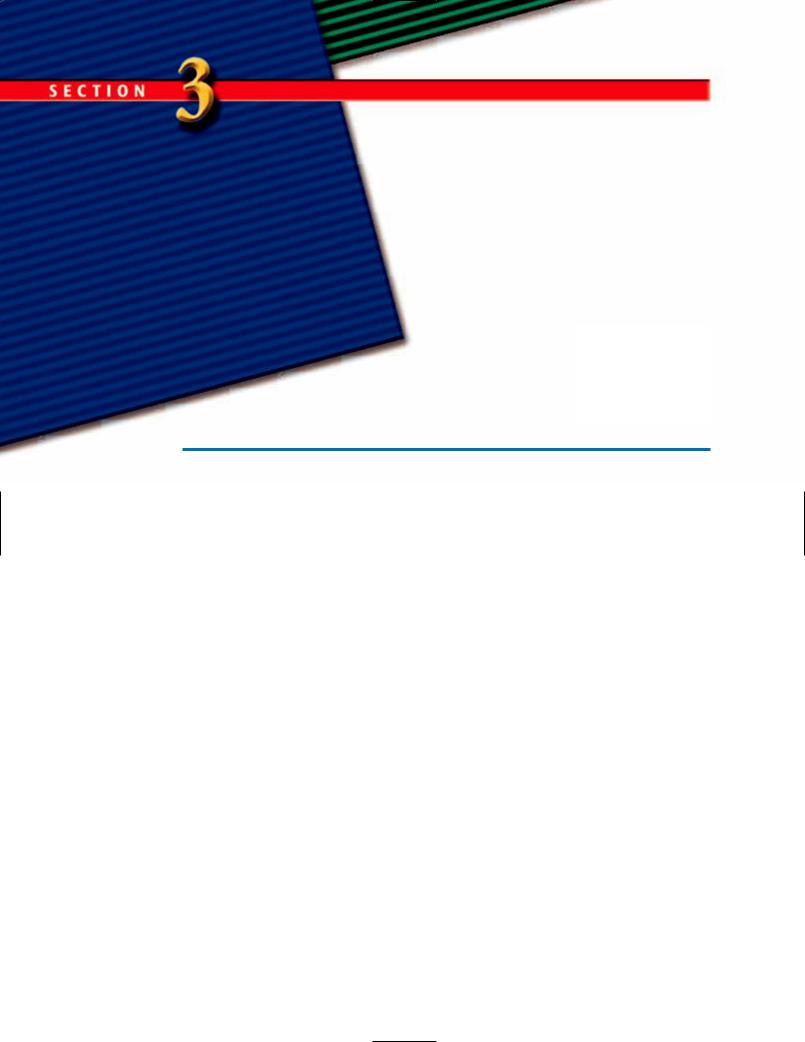
Revenue and
Its Applications
Focus Questions
What is total revenue?
What is marginal revenue?
Why does a business firm compare marginal revenue with marginal cost when deciding how many units of a good to produce?
Key Terms
marginal revenue
law of diminishing marginal returns
marginal revenue
The revenue from selling an additional unit of a good; the change in total revenue that results from selling an additional unit of output.
Total Revenue and
Marginal Revenue
In Chapter 3, total revenue was defined as the price of a good times the quantity sold. For example, if the price of a book is $15 and 100 are sold, then total revenue is $1,500. Consider the following: (1) Harris sells toys for a price of $10 each. (2) Harris currently sells 1,000 toys. (3) This means that Harris’s total revenue is $10,000. If Harris sells one more toy for $10, what is the change in total revenue that results from the change in output sold?
To answer this question, we first calculate what the total revenue is when Harris sells 1,001 instead of 1,000 toys; it is $10,010. We conclude that the total revenue changes from $10,000 to $10,010 when an additional toy is sold. In other words, a change in total revenue equals $10.
The change in total revenue (TR) that results from selling an additional unit of output is marginal revenue (MR). In other words, marginal revenue is the additional revenue from selling an additional unit of a
good. In the example, $10 is the marginal revenue. We can write it this way:
∆TR Marginal revenue (MR) ∆Q
Marginal revenue equals the change in total revenue divided by the change in the quantity of output sold.
Firms Have to Answer Questions
If you start up a business, you’re going to have to answer certain questions. For example, suppose you start a business producing and selling T-shirts. Someone comes up to you and asks: How many T-shirts are you going to produce each month? What is your answer going to be? Will you say 100, 1,000, or 10,000? How will you go about deciding how many T-shirts you’re going to produce? Are you going to put different numbers in a hat and simply draw one out? Whatever number you draw, will that be how many T-shirts you produce? Of course not! So, what are you going to do? How are you
176 Chapter 7 Business Operations

What questions do you think these business executives might be trying to answer?
going to decide how many T-shirts to produce? This is one question that every business firm has to answer:
How much should we produce?
Suppose you decide to produce 1,000 T-shirts a month. Now someone comes up to you and asks: What price will you charge for each T-shirt? What are you going to say? Are you going to say $10, or $10.50, or $15? How will you decide how much to charge for each T-shirt? Here then is a second question every firm has to answer:
What price should we charge?
In this section we will talk more about these two questions.
How Much Will a Firm
Produce?
Suppose again that you produce T-shirts. You have to decide how many to produce. What two pieces of information do you need before you can decide how many T-
shirts to produce? If you think about it, the answer is fairly simple. You need to know the marginal cost and the marginal revenue for your T-shirts. For example, suppose you are presented with the following data (which is representative of many real-world businesses):
T-shirts |
MR |
MC |
|
|
|
1st |
$10 |
$4 |
2nd |
$10 |
$6 |
3rd |
$10 |
$8 |
4th |
$10 |
$9.99 |
5th |
$10 |
$11 |
|
|
|
Having looked at the data, someone asks you: What is the right number of T-shirts for you to produce? What would your answer be? The correct answer is four T-shirts. In other words, you should keep producing T-shirts as long as marginal revenue (additional revenue of producing the additional T-shirt) is greater than the marginal cost (additional cost of producing the additional T-shirt). As long as what comes in through the “revenue door” is greater than what leaves through the “cost door,” you ought to keep producing T-shirts. Look at it this way:
MR > MC → Produce
MC > MR → Do not produce
Now if you want to produce as long as MR > MC, and you don’t want to produce if MC > MR, then ask yourself when you should stop producing. For example, you’ve already produced, say, 10,000 hats. Should you go ahead and produce one more? The answer is yes as long as marginal revenue is greater than marginal cost—even if the difference between marginal cost and marginal revenue is one penny (as was the case for the fourth T-shirt in the example).
Now suppose the difference is even less than one penny. Suppose it is half a penny. Should you still produce the good? Again the answer is yes. What about one-fourth of a penny? Yes, produce it. You can perhaps see where we are leading. Economists essentially say that it is beneficial to produce as long as marginal revenue is greater than
Section 3 Revenue and Its Applications 177
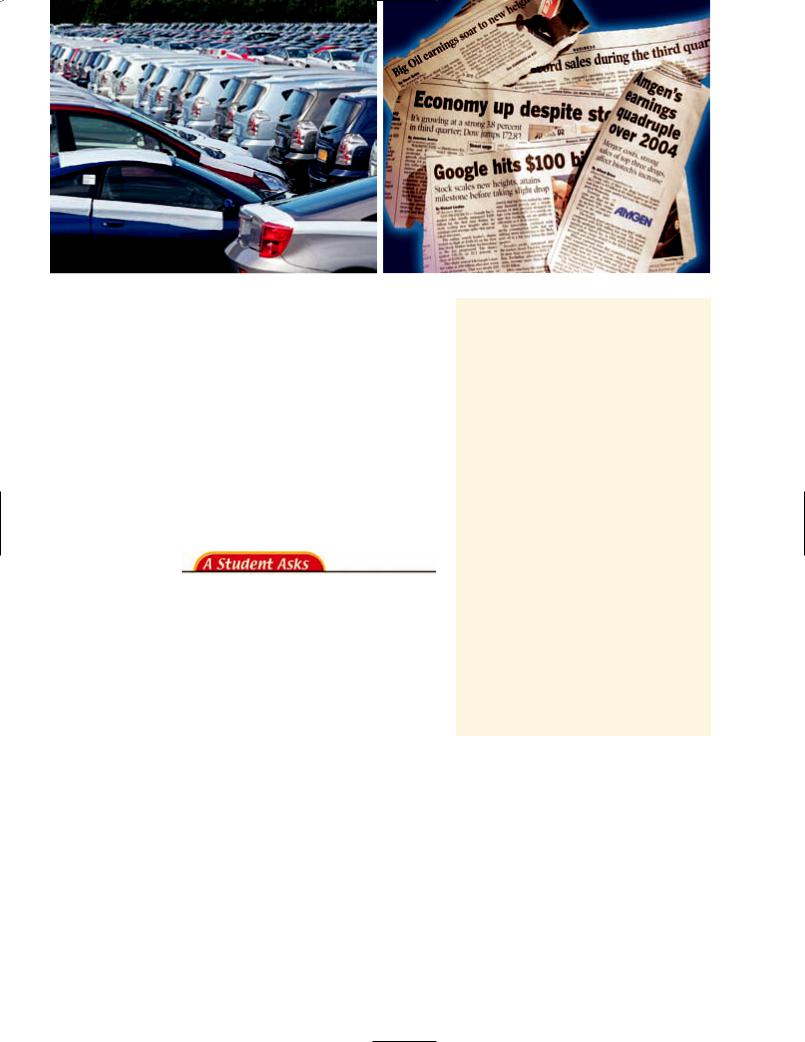
All companies |
marginal cost, even if the difference |
|
want to maximize |
between the two is extremely small. For all |
|
profits and generate |
practical purposes, then, economists are |
|
the kinds of results |
saying that a business firm should continue |
|
you see in the news- |
to produce additional units of its good until |
|
paper reports. How |
the marginal revenue (MR) is equal to the |
|
do automobile |
marginal cost (MC). |
|
manufacturers |
In the T-shirt example, we didn’t find any |
|
know how many |
unit of T-shirt at which MR MC, but we |
|
cars to produce |
did find one where there was only a penny |
|
and what does |
difference. We stopped producing after we |
|
that have to do |
had produced the fourth T-shirt because it |
|
with maximizing |
was as close to MR MC as we could get. |
|
profits? |
|
|
|
|
|
|
|
|
|
|
QUESTION: I have known some people |
|
|
who owned businesses and, to tell you |
|
|
the truth, I don’t think any one of them |
|
|
even knew what marginal revenue and |
|
|
marginal cost are. You can’t expect me to |
|
|
believe that these business owners were |
|
|
producing the quantity of output for |
|
|
which MR MC if they didn’t even |
|
|
know what MR and MC are. Please |
|
|
comment. |
|
|
ANSWER: You don’t always have to |
|
|
understand how to do something in |
|
|
order to do it. For example, not many |
|
|
people understand how their legs move |
|
|
to make them walk, or how their lungs |
|
|
behave to make them breathe, but still |
|
|
they walk and breathe. Our guess is |
|
|
that a bird doesn’t really understand |
|
|
aerodynamics (which is the study of |
|
|
forces and the resulting motion of |
|
|
|
objects through the air), but still birds can fly. A business owner may not know what marginal revenue and marginal cost are, but here is what a business owner does know: whether more money is “coming in” than is “going out.” And, of course, this is what marginal revenue and marginal cost really are. The additional money coming in is marginal revenue and the additional money going out is marginal cost. As long as a business owner can count, he or she will naturally end up producing the level of output at which MR MC. Having said all this, let us add that sometimes taking a course in economics or in business formalizes all these “business practices” more effectively. For example, a person who has studied economics would be less likely to make a mistake when determining what quantity of a good to produce than a person who has not studied economics.
What Every Firm Wants:
To Maximize Profit
In Chapter 3 we stated that profit is the difference between total revenue and total cost. For example, if total revenue is $400,000 and total cost is $320,000, then profit is $80,000. The firm wants profit to be as large as possible. An economist states it this way: The business firm wants to maximize profit.
178 Chapter 7 Business Operations
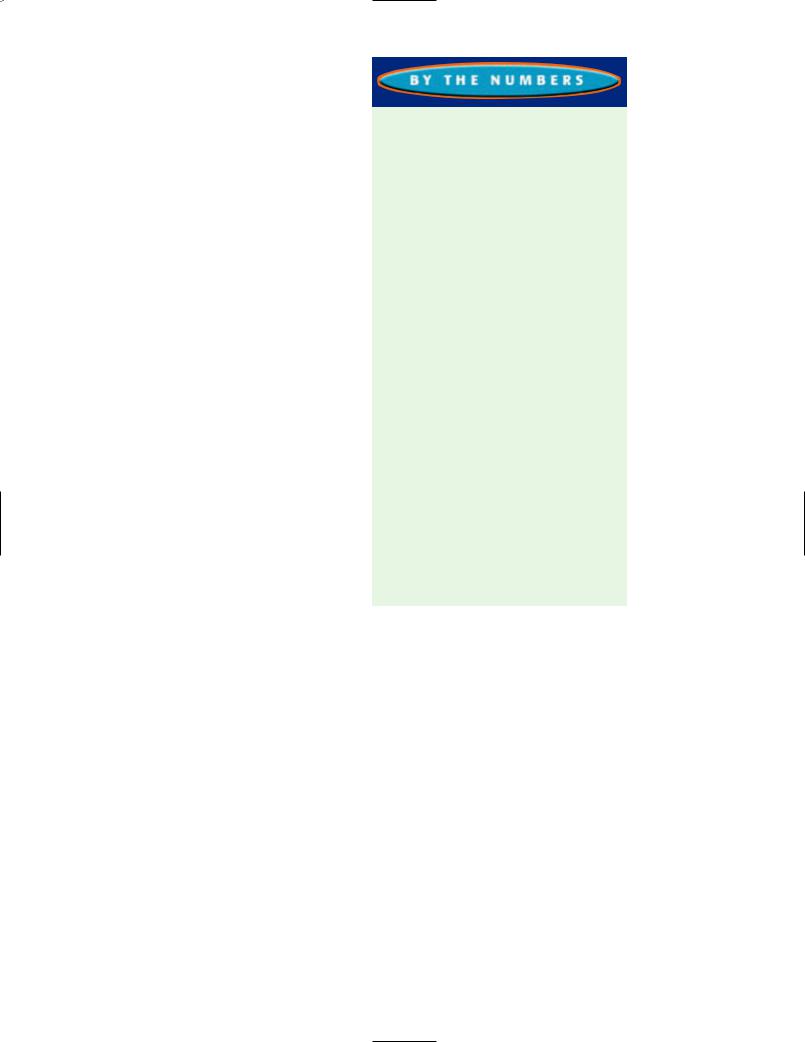
Of course if the firm wants to maximize profit, this is just another way of saying that it wants the biggest difference possible between its total revenue and its total cost. For example, given a choice of a total revenue of $1 million or $2 million, a business firm would prefer a total revenue of $2 million (all other things being equal). Or given a choice of a total cost of $250,000 or $500,000, a business firm would prefer a total cost of $250,000 (all other things being equal).
So, maximizing profit is consistent with a firm getting the largest possible difference between its total revenue and its total cost.
Now here is something to think about: Is getting the largest possible difference between total revenue and total cost the same thing as producing the quantity of output at which MR = MC? The answer is that “getting the largest possible difference between total revenue and total cost” is the same thing as producing the quantity of output at which MR MC. To prove it, again suppose that a business firm’s total revenue is $400,000, total cost is $320,000, and profit is $80,000. Now suppose it produces and sells an additional unit of a good. The additional revenue from selling this unit of the good (the marginal revenue) is $40, and the additional cost of producing this unit of the good (the marginal cost) is $10. Total revenue will rise to $400,040 ($400,000$40 $400,040), and total cost will rise to $320,010 ($320,000 $10 $320,010). What will happen to profit? It will increase to $80,030 ($400,040 $320,010 $80,030). Thus, whenever the firm produces and sells an additional unit of a good and marginal revenue is greater than marginal cost, it is adding more to its total revenue than to its total cost, and therefore it is maximizing profit.
How to Compute Profit and Loss
When a firm computes its profit or loss, it determines total cost and total revenue and then finds the difference:
1.To compute total cost (TC), add fixed cost (FC) to variable cost (VC).
TC FC VC
We buy things from stores every day. Some of the businesses that own those stores earn more (per square foot of space and per store) than do others. Here is a list of wellknown businesses and the revenue that each earns per store and per square foot of space.
Most of the dollar amounts are for 2003.
Revenue per |
Revenue |
|
Company |
square foot |
per store |
Abercrombie |
$379 |
$ 2,766,639 |
and Fitch |
|
|
|
|
|
Nordstrom |
319 |
37,112,273 |
Foot Locker |
316 |
1,249,896 |
|
|
|
Wal-Mart |
422 |
55,924,898 |
Target |
278 |
32,942,045 |
|
|
|
Sports Chalet |
241 |
8,816,037 |
Barnes & Noble |
243 |
5,865,314 |
|
|
|
Borders |
237 |
6,000,000 |
Sharper Image |
627 |
2,509,051 |
|
|
|
Radio Shack |
342 |
829,841 |
Walgreens |
709 |
7,748,507 |
|
|
|
Home Depot |
370 |
40,144,000 |
Krispy Kreme |
859 |
3,952,000 |
|
|
|
McDonald’s |
543 |
1,628,000 |
Domino’s Pizza |
527 |
605,879 |
|
|
|
Starbucks Coffee |
521 |
781,669 |
Source: BizStats.com.
2.To compute total revenue (TR), multiply the price of the good (P) times the quantity of units (Q) of the good sold.
P Q TR
3.To compute profit (or loss), subtract total cost (TC) from total revenue (TR).
Profit (or loss) TR TC
 Suppose variable cost is $100 and fixed cost is $400. It follows that total cost is $500. Now suppose that 100 units of a good are sold at $7 each; total revenue is then $700. If we subtract total cost ($500) from total revenue ($700), we are left with a profit of $200.
Suppose variable cost is $100 and fixed cost is $400. It follows that total cost is $500. Now suppose that 100 units of a good are sold at $7 each; total revenue is then $700. If we subtract total cost ($500) from total revenue ($700), we are left with a profit of $200.
Section 3 Revenue and Its Applications 179

law of diminishing marginal returns
A law that states that if additional units of one resource are added to another resource in fixed supply, eventually the additional output will decrease.
How Many Workers Should
the Firm Hire?
Wal-Mart has more than 1 million employees. In fact, it has somewhere closer to 1.2 million employees. How does WalMart know how many employees to hire? Did the president of the company simply say one day, “1,199,278 employees sounds like the right number of employees to me, so let’s go with it”? We doubt it.
The fact is, every business has to decide how many employees it will hire (just as we learned that every business has to decide how much it will produce). Let’s begin the story of how a firm decides how many employees to hire by first discussing the law of
diminishing marginal returns.
The name of this “economic law” sounds worse than it is. (If you understood the law of diminishing marginal utility back in Chapter 4, you shouldn’t have too much trouble understanding the law of diminishing marginal returns.) It states that if we add additional units of a resource (such as labor) to another resource (such as capital) that is in fixed supply, eventually the addi-
Who Benefits?
Increased globalization will place some U.S. companies in a more competitive market setting.
A study for the Institute for International Economics found that,
between 1979 and 1999, some American workers lost jobs because they worked for U.S. companies that produced goods that couldn’t compete in price with foreign-produced imported goods. Many of these workers found other jobs, but 55 percent of those who found new jobs did so at lower pay, and 25 percent took pay cuts of 30 percent or more.
Is increased globalization more likely to benefit a larger percentage of U.S. con-
sumers or a larger percentage of U.S. workers?
tional output produced (as a result of hiring an additional worker) will decrease.
The best way to illustrate the law is with numbers. Take a look at Exhibit 7-6. Reading across the first row, we see that with zero workers, no output occurs. Now when one worker is added, the quantity of output (shown in the second column) is 5 units. The third column shows the additional output produced as a result of hiring an additional worker. If output is zero with no workers and 5 units with one worker, we conclude that hiring an additional (the first) worker increased output by 5 units.
When a second worker is added, the quantity of output (shown in column 2) increases to 11 units. How much did output increase as a result of an additional (the second) worker? The answer is 6 units, as shown in column 3. If a third worker is added, output rises to 18 units, and the additional output produced as a result of the hiring of an additional (the third) worker is 7 units, as shown in column 3.
Before we go on, notice what has been happening in column 3: the numbers have been increasing, from 0 to 5, then 6, then 7. Notice that when a fourth worker is added, output increases to 23 units; the additional output produced is 5 units, which is less than the output produced as a result of adding the third worker.
What we are observing here is the law of diminishing marginal returns, which states that eventually the additional output produced (as a result of hiring an additional worker) will decrease. We added another worker (the fourth worker) here, and the additional output (shown in column 3) decreased from 7 to 5 units. In short, diminishing marginal returns set in with the addition of the fourth worker.
Now what does the law of diminishing marginal returns have to do with hiring employees? The answer is everything, once we turn the factors into dollars. To understand this concept, ask yourself whether you would hire the fourth worker if you owned a business.
To really be able to answer this question, you would first have to ask yourself two questions:
180 Chapter 7 Business Operations
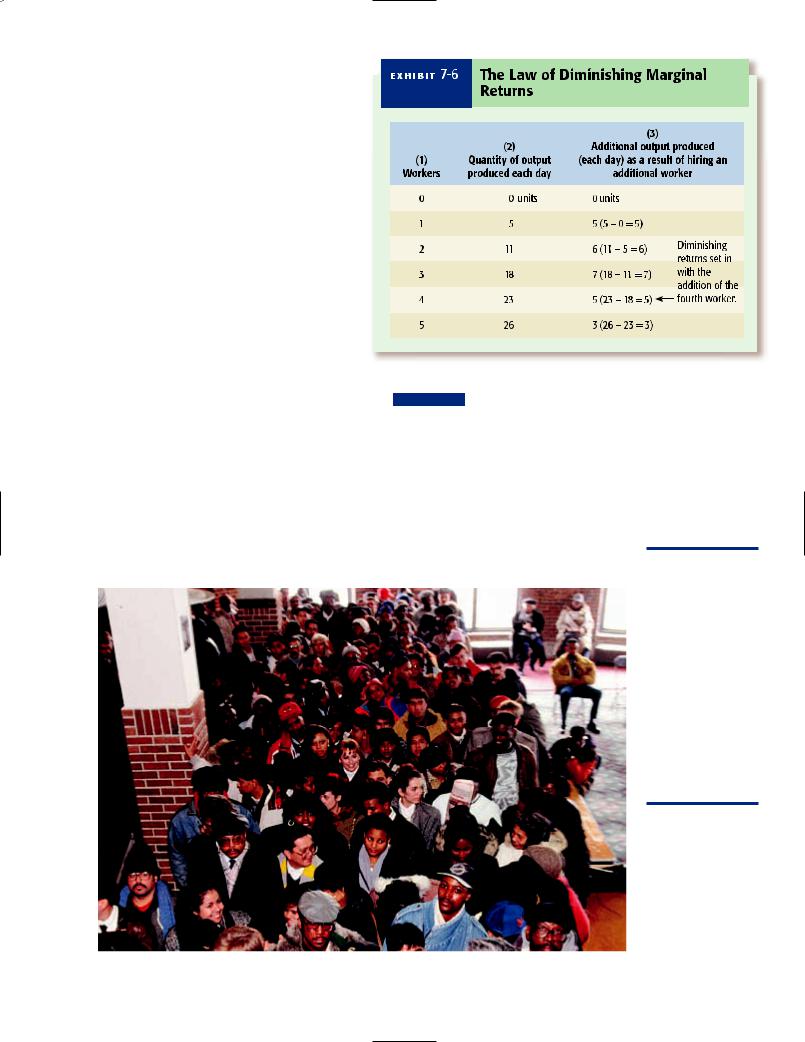
1.What do I sell each unit of output for?
2.What do I have to pay to hire the fourth worker?
Suppose you sell each unit of output for $30 and you will have to pay the fourth worker a wage of $70. Would you hire the fourth worker? One way to figure out the answer is to calculate how much “comes in” the door with the fourth worker compared to how much “goes out” the door with the fourth worker. The worker produces 5 more units of output, and you can sell each unit for $30, so the worker really “comes in” the door with $150. You have to pay the fourth worker $70, so the worker “goes out” the door with this amount. Would you be willing to pay someone $70 to get $150 in return? Sure you would, so you should hire the fourth worker.
What is the general rule now for hiring employees? As long as the additional output produced by the additional worker multiplied by the price of the good is greater than the wage you have to pay the worker, then hire the worker. If the additional output produced by the additional worker multiplied by the price of the good is less than the wage you have to pay the worker, then don’t hire the worker.
If Bob hires Marianne, output will rise by 7 units a day. Bob can sell each unit of output for $50. To hire Marianne, Bob will have to pay her $200 a day. Should Bob hire Marianne? Sure he should. Output increases by 7 units a day and Bob sells each unit for $50, so Marianne brings $350 a day to Bob. Bob has to pay Marianne only $200 a day. Who wouldn’t spend $200 to get $350?
As more workers are added (column 1), the quantity of output produced each day rises (column 2). It isn’t until the fourth worker that diminishing marginal returns are said to set in.
Hundreds of job seekers apply for positions prior to the opening of a new hotel. What economic principle might the hotel managers use in deciding how many of the applicants they will hire?
Section 3 Revenue and Its Applications 181

How Much Time
Should You Study?
??????????????????
Abusiness firm can produce anywhere from one to millions of units of a good. What is the
right amount? As the chapter explains, it is the amount of the good at which marginal revenue equals marginal cost.
To determine the right amount of something, an economist would say we need to consider marginal costs and marginal benefits. For example, studying, sleeping, eating, working, and vacation-
How much of any activity is too little, how much is too much, and how much is the right amount? The answer is simple, says the economist: the right amount of anything is the amount at which
the marginal benefits equal the |
THINK |
Suppose Exhibit 7-7 |
||
marginal costs. |
|
ABOUT IT |
represents your mar- |
|
Suppose the marginal (addi- |
ginal benefits and marginal costs |
|||
tional) benefits of studying start |
of studying. In other words, the |
|||
out high and decrease with time, |
right amount of time for you to |
|||
as illustrated in Exhibit 7-7 with a |
study is two hours. Then one day, |
|||
downward-sloping marginal benefit |
your economics teacher talks |
|||
curve (for studying). This curve says |
about the benefits of learning |
|||
that you benefit more from the first |
economics. Afterward, you realize |
|||
minute of studying than the second |
that there are more benefits to |
|||
minute, more from the second |
|
learning economics than you had |
||
minute than the third, and so on. |
thought. Will this change the |
|||
Assume that the marginal costs |
amount of time you study econom- |
|||
of studying are constant over time. |
ics? Explain your answer in terms |
|||
In other words, you are giving up as |
of Exhibit 7-7. |
|
||
much by studying the first minute |
|
|
|
|
as the second minute, and |
|
|
|
|
so on. In the exhibit, the |
|
|
|
|
marginal cost curve (of |
E X H I B I T 7-7 |
The Marginal |
||
studying) is horizontal to |
|
|
Benefits and |
|
illustrate this point. |
|
|
Marginal Costs of |
|
A quick look at Exhibit |
|
|
Studying |
|
7-7 says that the right |
|
|
|
|
amount of time to study is |
|
Marginal benefits |
|
|
two hours. If you study less |
Marginal benefits, |
|
|
|
than two hours (say, one |
marginal costs |
|
s |
|
hour), you will forfeit all the |
|
g |
||
|
|
|||
net benefits (marginal ben- |
|
|
||
efits greater than marginal |
|
|
||
costs) you could have |
|
|
||
reaped by studying an addi- |
|
|
||
|
|
|
|
|
tional hour. If you study |
|
0 |
2 |
3 |
more than two hours, you |
|
|||
|
Hours spent studying |
|||
are entering into the region |
|
|||
where marginal costs (of |
|
|
|
|
studying) are greater than |
What is the right amount of time to study? |
|||
marginal benefits. The rule |
Study as long as the marginal benefits of |
|||
is this: do something as |
studying are greater than the marginal costs, |
|||
long as marginal benefits |
and quit when the marginal benefits equal the |
|||
are greater than marginal |
marginal costs. In the diagram, this time |
|||
costs, and stop when they |
comes at two hours of studying. |
|
||
are equal. |
|
|
|
|
182 Chapter 7 Business Operations
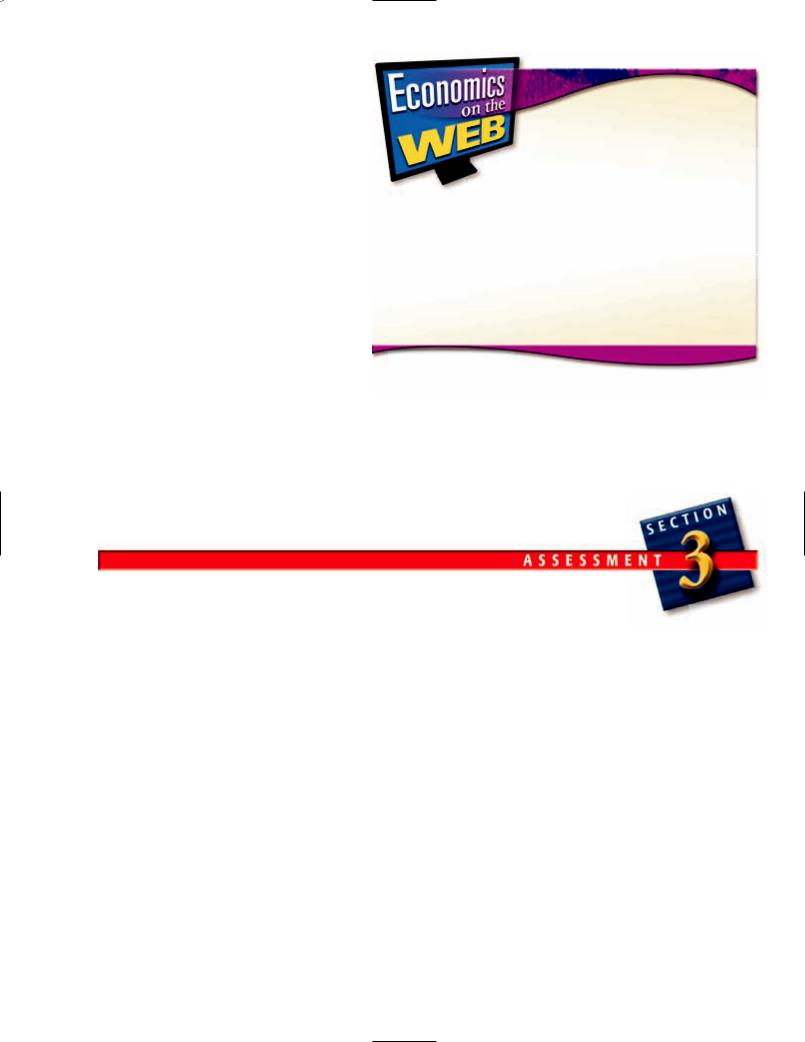
Reread the previous example from Marianne’s point of view. Do you think that Bob is cheating Marianne by paying her only $200 a day? After all, she brings in $350 a day to Bob. Shouldn’t Marianne get more than $200 a day if she makes Bob $350 better off a day?
You need to keep in mind that things are a little more complicated than we have made them out to be. Marianne could very well be working with other employees and with certain machines. Not all of what Marianne “produces”for Bob is the result of Marianne’s work, and her work alone. She brings “$350 a day to Bob,” that is true. But it is really her working with other employees and with certain machinery or tools that ends up producing $350 a day more for Bob.
To illustrate, let’s suppose someone goes to work on a farm. We might say that 100 more bushels of wheat were harvested on a given day. Is it that new worker who harvests those 100 additional bushels or is it the new worker using a tractor (which is a
ach year Fortune magazine Eranks the top 500 corporations
in the United States according to revenue. In recent years, a few of
the largest revenue-earning corporations in the United States include Wal-Mart, Exxon, General Motors, and Ford Motor Company. If you want to find the most recent list of the Fortune 500, go to www.emcp.net/fortune. If you would like to learn what some of America’s highest-paid business executives earn, go to www.emcp.net/forbes and do a site search for “Top Paid CEOs.”
tional bushels of wheat? The answer is that it is the new worker using the tractor. The same type of story can be told for Marianne. People don’t usually work in isolation from other people or without certain
Defining Terms
1.Define:
a.marginal revenue
b.law of diminishing marginal returns
Reviewing Facts and
Concepts
2.The additional output obtained by adding an additional worker is 50 units. Each unit can be sold for $2. Is it worth hiring the additional worker if she is paid $150 a day? Explain your answer.
3.Price is $20 per unit no matter how many units a firm sells. What is the marginal revenue for the
50th unit? Explain your answer.
Critical Thinking
4.This section explained how a firm computes profit. Specifically, it computes total cost and total revenue and then finds the difference. Suppose a firm wants to compute its profit per unit. In other words, instead of computing how much profit it earns in total, it wants to know how much profit it earns per unit. How could the firm go about computing profit per unit? (Hint:
The answer deals with average total cost.)
Graphing Economics
5.Suppose the marginal benefits of playing tennis are constant for each minute of the first 20 minutes and then steadily decline for each additional minute. The marginal costs of playing tennis are constant. Furthermore, marginal costs are equal to marginal benefits at the 45th minute. Diagrammatically represent the marginal benefits and marginal costs of playing tennis.
Section 3 Revenue and Its Applications 183
